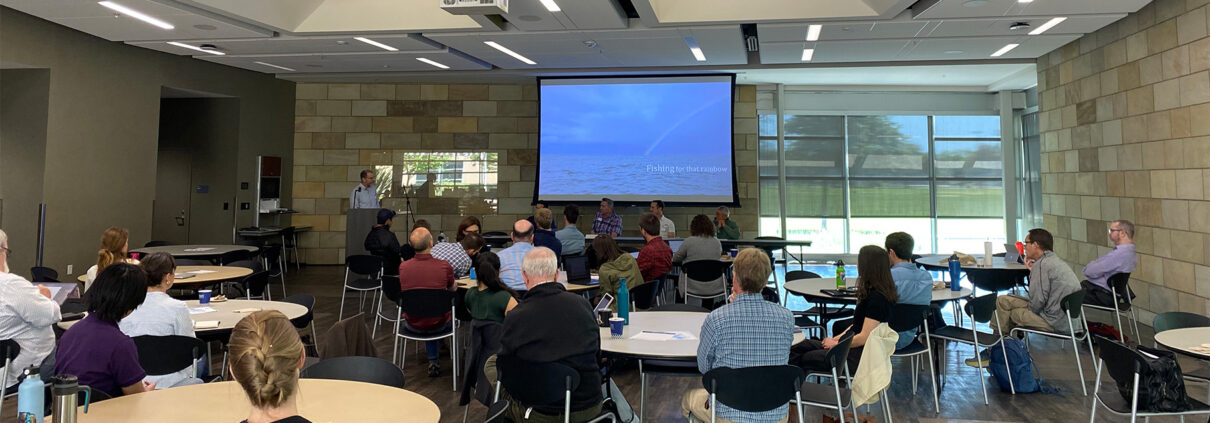Through conversations with state and federal partners and stakeholders from the fisheries sector, OST and our UC Davis research partners realized that there was a need for a venue to discuss both how the federal fishery disaster assistance program can be improved to support fishing communities, and whether other opportunities may exist to help alleviate the challenges that unexpected environmental impacts place on fishing communities and fisheries. As a result, we convened a symposium on May 2, 2024 on UC Davis campus to discuss the sustainability of the federal fishery disaster declaration program in light of climate change impacts, and explore additional tools to mitigate community impacts in the future.
A symposium held in partnership with UC Davis explored fishery disaster support mechanisms for fishing communities
By Monica LeFlore
May 7, 2024Why fishery disasters?
Context: West Coast fishery disasters
Fishery resource disasters are sudden, unexpected, large decreases in fish stock biomass or changes that result in significant loss of access to a fishery resource. Disaster frequency has been increasing nationwide, and are expected to continue increasing in frequency and intensity as climate change impacts are realized. Recent examples include the California commercial red sea urchin fishery disaster in 2016, primarily driven by kelp forest loss due to warmer waters and uncontrolled purple sea urchin grazing, and the 2023 California salmon fishery disaster, a full closure of the fishing season due to extremely low population estimates. Fishery impacts such as these can in turn cause massive economic losses for associated fishing communities, who may be reliant on revenue from fishing operations. To provide relief for affected parties like fishermen, ports, and processors, states, and tribal governments typically request disaster aid through the federal fishery disaster assistance program.
Symposium conversations
The symposium consisted of four panels: (1) Overview of the Federal Fishery Disaster Declaration Process, (2) Predictability of Climate-Related Fishery Impacts and Socioeconomic Responses, (3) Future Strategies for Coping with Fishery Disasters, and (4) Reflections on the Day’s Discussion. Panelists represented several different sectors, including the fishing industry, academia, non-governmental organizations, and the federal government. The audience was comprised of individuals representing the fishing industry, California state officials from the Ocean Protection Council, Department of Fish and Wildlife, Fish and Game Commission, the Pacific Fisheries Management Council, federal officials from NOAA headquarters and the West Coast Regional Office, academics from West Coast institutions, non-governmental organizations including Ocean Conservancy and The Nature Conservancy, and graduate students researching coastal and marine management. Having a diversity of perspectives in the room made for lively and informative discussion. Here are my takeaways from the symposium as someone whose interest lies at the science-policy nexus:
- • The process to request a federal fishery disaster declaration and receive disaster aid is time- and expertise-intensive for both applicants and those processing requests. In order to produce a complete request, states and tribes must compile difficult-to-attain data on economic impact from fishery disasters, which requires immense (and often costly) personnel capacity and economic expertise. Once NOAA Fisheries receives a request, processing the application requires substantial inter-office coordination; if you aren’t familiar with the process, this infographic developed by NOAA Fisheries is a helpful starting point to understand the breadth of federal offices involved in reviewing requests.
- • It is difficult for fishing communities to weather the time between when a fishery disaster occurs and when federal aid is disbursed. Not all disaster requests are approved, but even once they are, disbursement of aid funds requires both a congressional allocation and development of a spending plan, both processes that can take many months to complete. Many conversations at the symposium centered around how the process can be made more efficient.
- • There is interest in and a need for further discussing equity in fishery disaster relief. At several junctures, symposium discussions arrived at the challenge of accurately assessing and compensating economic loss in the fisheries sector, for example because it is not common practice to keep track of affected crew members and ancillary businesses.
- • Creative frameworks outside disaster declarations warrant further exploration as potential tools for helping fishing communities bridge the gap between when disasters occur and when federal aid is disbursed. Insurance, for example, was raised several times as a future option to explore in helping fishing communities prepare for future disasters, and developing a pilot project to attempt this avenue may be an appropriate next step. Diversification in many forms, including fishery diversification, temporal diversification, livelihood diversification, and income diversification were also raised as options for increasing resilience under climate change.
Next steps
On the day following the public symposium, OST and UC Davis convened a smaller gathering of symposium panelists to digest conversations and strategize how to ensure that key takeaways are preserved following the event. As an immediate next step, we are in the early stages of summarizing a more detailed report out of the takeaways and key questions raised by this first discussion, which we hope will provide insight to researchers, policy-makers, and community representatives as they continue to explore future actions and conversations on this topic.




